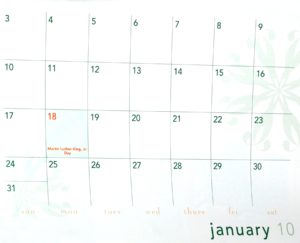How to get organized and make life easier
Life used to be a smorgasbord of problems for me. I have to admit it was self-inflicted, but every day was one disaster after another: Frequently, I’d be late for work, because I could not find my car keys. Sometimes, I didn’t have the right ingredients for the recipe I was making for dinner. (I was just at the store!??) I’d schedule a talk with my boss, and always forget to bring up at least one issue that needed his attention or approval. It seemed I spent half of my life digging out from one problem just to find myself in another. Does this sound familiar? My problem was i was not organized. How does a person get organized?
I remember the day I saw the light. I was attending the local junior college, and because I couldn’t find the books I needed that day, I was late to class—again. (The light i saw was the light that said “you have got to get organized”!!
Because I had been late so many times, my college counselor called me in to her office. The short story is that after discussing the problem of getting to class on time, we discussed a few other problems I was having. Finally, my counselor made the statement that changed my life. “You without a doubt are the most disorganized person I have ever met. It’s a wonder you were on time to this appointment”. The moment she said it, I knew she was right. I needed to get organized.
Important Note
If you ever decide to live the frugal lifestyle, exercising good organizational skills are a must.
So what does “organized” mean?
Being organized is having one’s affairs in order so as to deal with them efficiently.
This means no more being late to work because you can’t find your car keys. No more overdrafts on your checking account because you forgot to deposit a check or balance your checkbook. No more second trips to the grocery store because you forgot something. The goal is to do it right the first time, and forget nothing.
The actual state of being organized will vary from person to person, but organized people have one thing in common: They deal with their affairs efficiently.
How to get organized (How I got organized)
I had two major problems:
1. I was not performing up to par at work, at school, or at home. I was missing too many details. Work and school assignments weren’t getting done on time—sometimes not at all. At home I had the same problem; I was letting too many things slide.
2. I spent entirely too much time looking for things I should not have had to look for: car keys, school books, checkbook…
I recognized the problems, and I worked on them simultaneously.
This is what I did to get organized.
I bought three notebooks: one for home, one for work, and one to carry with me at all times. (This last one was the beginning of my “to do” lists; my first notation in it every day was the date.) I, also, purchased two desk calendars/schedulers: one for work, and one for home. I’d go about my daily life, and things that needed to be done would come to mind. As that happened I began to write them down in the notebook I carried with me at all times. If it was a work related item I would write “W” beside it, and if it was a home related item I would write an “H” beside it. (This was a big change from what had been my usual, “I’ll think about that later” mode, and it was—and continues to be—hugely helpful.)
Just as a note: If it were not “work” related it was “home” related, and home included school.
Work application
Before leaving for the day, I transcribe the items that pertain to work from the notebook I carry to the one that stays at my desk, and I assign each item a priority. The priority system I use is A B C. Items marked with an “A” are most important. Those marked with a “C” are the least important. The next time I worked (usually the next morning) I’d transfer the items from the work notebook to my scheduler—giving me dates and times to work on specific projects. After that it was easy to see what I needed to accomplish on any particular day. When an item was completed, I single-lined it off my scheduler, the notebook for work, and the notebook I carry.
If I started but couldn’t complete something, or couldn’t get to it at all—usually a “B” or “C” item—I’d reschedule for a later time or date. When I had to do this, its priority was likely to change. “A” items need to get done. (It’s probably no surprise to you that rescheduled items tend to become more urgent.) Other than, perhaps, changing their priority, these items were entered into my system the same way they’d been done the first time, beginning with a notation in the notebook I carried with me. Until they’d been completed (and this is important), these items were never lined-out anywhere. This let me track through my scheduler and notebooks the number of times any particular item had been rescheduled.
A bonus that developed from doing things this way is that I, eventually, saw a pattern in the type of things on which I procrastinated, and could work at breaking that habit. (Procrastination usually costs something, and that puts it at odds with a frugal lifestyle.)
At home
The mechanics were the same as at work. During the day (actually, any time), if something occurred to me that needed to be done at home, I’d jot it down in that notebook I carried with me. Anything listed that pertained to “home life” got moved to my at home notebook, and then entered into my home scheduler before I went to bed.
School related assignments, appointments, etc. were consigned as “home” entries for scheduling purposes. Medical and other appointments were placed in either the “home” or “work” scheduler”—depending on where I would be when I had to leave for them.
Repetitive tasks
At work as well as at home, there are events that consistently reoccur. The garbage man comes on the same day of the week, every week. (Don’t want to forget to take the trash out!) From April through October, I mow a friend’s yard every two weeks on Saturdays. On the third Thursday of any month, we’re likely to have a safety meeting at work… When one of these events shows up on my scheduler, I note it with an “r” for “repeat” and a “d,” “w,” “m,” or “y” indicating (in this number of) “days,” “weeks,” “months,” or “years.” For example, if the trash is picked up on Tuesdays, I should have that noted in my home scheduler on any (actually, every) Tuesday as “Trash P/U r1w”. So, when I look at the scheduler on Tuesday morning and see that entry, I know (1) to move the trashcan to the curb, and (2) to check that I have, indeed, recorded the event to happen again on the following Tuesday. Using this method, it wasn’t long before I had all events scheduled: birthdays, soccer games, regular meetings… Wow this was working pretty good.
Lists
If I leave to my home or office to do more than one thing, to make sure I don’t forget one of my stops along the way, I take an itinerary (a list) with me. If I’m headed to the store, I take a shopping list—just to be sure I don’t forget anything.
Everything has a home
This was the harder task for me, I was used to dropping everything wherever, and that is where it stayed—maybe—until I was lucky enough to find it again. (Life can be brutal if you live like this.) After that talk with my college counselor, I realized how much time it cost me to always have to search for every anything. I needed to assign specific places for my things and make sure I put them in those places.
Everything needed a home.
I left nothing out. If it was at my office or in my home there was a right place for it, and there would be only one right place for it: That’s where it belonged if it was not in use.
It took awhile, but eventually I knew exactly where everything went and got in the habit of putting it there. I will tell you, it wasn’t easy for me. I was used to just dropping whatever I had in my hands and getting on with the next thing—after I found it. And, of course, my searches usually involved tossing things until I found what I was after, or I just gave up. Either way my stuff just got more jumbled. Adopting order required thought and practice.
Conclusion
I’m sixty years old. I’ve used this system for the past forty years. Because life happens from time to time, some of the circumstances were subject to change. For example, during my last tour with the U.S. Army I didn’t cook. I ate in a dining facility. I didn’t go shopping for groceries. So, I didn’t have a kitchen to keep in order, and I didn’t need to use grocery lists. I did, however, have responsibilities and was in charge of specific areas. My scheduling system adapted very well to that work, and while it didn’t matter where in the world I was, it did matter that I could easily locate the things I was responsible for. I’m glad I’ve learned how to get organized under any circumstances.
Never miss another post follow me on Facebook



